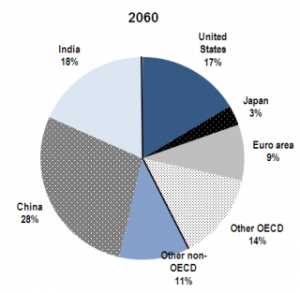The balance of economic power is expected to shift dramatically over the next half century, with fast-growing emerging-market economies accounting for an ever-increasing share of global output, according to a new OECD report.
Divergent long-term growth patterns lead to radical shifts in the relative size of economies, according to this report by the Organisation for Economic Co-operation and Development (OECD), which groups 34 most industrialised countries.The United States is expected to cede its place as the world’s largest economy to China, as early as 2016. India’s GDP is also expected to pass that of the United States over the long term. Combined, the two Asian giants will soon surpass the collective economy of the G7 nations.
Fast-ageing Japan, Euro Zone to Lose Ground
Fast-ageing economic heavyweights, such as Japan and the euro area, will gradually lose ground on the global GDP table to countries with a younger population, like Indonesia and Brazil.
Looking to 2060: A Global Vision of Long-term Growth uses a new model for projecting growth in the 34 OECD members and 8 major non-OECD G20 economies over the next 50 years.
The report forecasts global economic growth of 3 percent annually, with sharp differences between the emerging-market economies, which are expected to grow at a much faster pace, and the advanced countries, which will likely grow at slower and often declining rates.
Cross-country GDP per capita differences mainly reflect differences in technology levels, capital intensity, human capital and skills.
“The economic crisis we have been living with for the past five years will eventually be overcome, but the world our children and grandchildren inherit may be starkly different from ours,” said OECD Secretary-General Angel Gurría.
Education, Productivity
As the largest and fastest-growing emerging countries fully assume a more prominent place in the global economy, we will face new challenges to ensure a prosperous and sustainable world for all.
Education and productivity will be the main drivers of future growth, and should be policy priorities worldwide.
The shifting balance of long-term global output will lead to corresponding improvements in living standards, with income per capita expected to more than quadruple in the poorest countries by 2060.
“China will See More than a Seven-fold Increase in Per Capita Income”
The increase could even be seven-fold in China and India. With these gains, the gap that currently exists in living standards between emerging-markets and advanced economies will have narrowed by 2060.
But large cross-country differences will persist. China will see more than a seven-fold increase in per capita income over the coming half century, but living standards will still only be 60% of that in the leading countries in 2060.
India will experience similar growth, but its per capita income will only be about 25% of that in advanced countries.
“None of these forecasts are set in stone,” Mr. Gurría said. “We know that bold structural reforms can boost long-term growth and living standards in advanced and emerging-market economies alike.”
OECD research shows that wide-ranging labour and product market reforms could raise long-term living standards by an average of 16% over the next 50 years relative to the baseline scenario, which only assumes moderate policy improvements.
Read OECD Report Looking to 2060: Long-term growth prospects for the world (download the pdf version)
*Source: OECD release.










